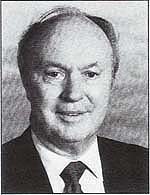All Issues
IPM: reshaping the approach to pest management
Publication Information
California Agriculture 44(5):2-2.
Published September 01, 1990
PDF | Citation | Permissions
Full text
Today the successful farmer knows that synthetic pesticides also have significant limitations-some pests develop resistance to chemicals; the pesticides have become increasingly costly; and they can impact the environment and grower and worker health. Together, those concerns are setting a new pattern in agriculture. Now California farmers often have an important secondary goal when they choose pest management practices-to reduce or eliminate much of the pesticide load they once might have applied to their crops. Farmers today look at a wider range of options for pest management.
The source for many of those options is the University of California's Statewide Integrated Pest Management (IPM) Project. The IPM Project, which celebrates its tenth anniversary this year, is profiled in this issue of California Agriculture. Over the past decade, the University's IPM effort has developed and disseminated biological and cultural pest management practices that offer farmers alternatives to total dependence on synthetic pesticides. The IPM Project was developed by the University with the support and encouragement of the California Legislature, and is the national leader in this area. No other IPM program has done so much for so many commodities.
IPM is a thinking farmer's philosophy for pest management. A thoughtful, comprehensive approach to the challenges of farming, it calls on many different disciplines, seeking links and relationships among them rather than seeking to establish a separate science. It is an environmentally based pest control strategy offered as part of an overall crop production system. IPM provides a diverse array of practices that can be used together to fight farm pests in an economically and environmentally efficient manner. By adopting a season-long and even a multi-season perspective, IPM systems take maximum advantage of naturally occurring factors to increase pest mortality, such as biological controls and favorable environmental and climatic conditions. Some IPM practices introduce, conserve or enhance predators and parasites to control pests. Others depend more on cultural techniques.
An integrated approach does make use of synthetic pesticides when they are warranted. But the IPM philosophy also considers synthetic pesticides to be a last resort. That view can, and often does, lead to reduced pesticide use. For example, after California almond growers generally adopted IPM practices in the early 1980s, their use of insecticides declined by 45%. Almond growers now achieve better control of pests while using less pesticide through techniques that include increased orchard sanitation, intensive monitoring of insect populations, and early harvest. Another example is a pest sampling program for Brussels sprouts developed by a group of Central Coast IPM Advisors. That system enables some growers to reduce their aphid control sprays from seven applications to one.
IPM is not an idea that has just reached the consciousness of farmers and agricultural researchers. More than half a century ago, in 1939, A. E. Michelbacher of UC Berkeley laid the foundation for IPM concepts in a work entitled “Recommendations for a More Discriminating Use of Pesticides.” Later, he coined the term “integrated control” for the integration of biological and chemical controls on walnuts. Michelbacher and other researchers of his era, such as Vern Stern and Paul DeBach at UC Riverside and Robert Vander Bosch and Ray Smith at UC Berkeley, helped develop the IPM approach. In the mid-1950s, the challenge posed by the spotted alfalfa aphid in California fostered development of IPM techniques that today have spread throughout the farming industry.
The University's Statewide IPM Project began formal operation under the direction of Ivan Thomason in 1980. The program leverages a remarkably diverse research and education program with a modest budget of $2.1 million in state funds. The research arm has funded 222 projects in 35 different commodities over the past decade. The resulting information forms a vast base of science on which practical programs can be built. The research draws on the experience and knowledge of hundreds of scientists in a variety of disciplines. Research subjects often seem prosaic, such as finding better ways to count minute insects on a leaf. Sometimes they seem exotic, such as seeking a way to extract marigold fluids for use as natural insecticides.
The IPM Project's sophisticated education arm is the other key to its success in bringing new methods to hundreds of California growers. It provides access to IPM information through a sophisticated computer system, eleven nationally acclaimed IPM manuals, and annual training conferences for pest management professionals. Recently the IPM Project began educational programs in the important areas of farm worker pesticide safety and pesticide applicator safety. IPM Area Advisors work in all regions of the state with other UC Cooperative Extension Farm Advisors, with professional pest control advisers, and directly with farmers.
IPM will continue to evolve as growers continue to confront the multitude of pest challenges. New approaches will be developed and tried for the vast array of pests threatening California's 250 different crops. Certainly the economic and policy pressures from within the industry and from the public at large will encourage greater interest in and use of IPM techniques. With an integrated view of pest management, California growers can survive and thrive in the 1990s, and the public can maintain its confidence in the state's food and fiber production system. IPM is a vehicle that can help maintain the flow of good food to the dinner tables of the nation while reducing the risks associated with use of synthetic pesticides.





